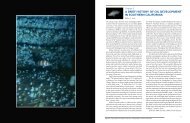checklist (pdf) - The Love Lab - University of California, Santa Barbara
checklist (pdf) - The Love Lab - University of California, Santa Barbara
checklist (pdf) - The Love Lab - University of California, Santa Barbara
Create successful ePaper yourself
Turn your PDF publications into a flip-book with our unique Google optimized e-Paper software.
Scomber japonicus Houttuyn, 1782. Chub Mackerel, Pacific Chub Mackerel, or Pacific Mackerel. To nearly<br />
63.5 cm (25 in) TL (Fitch 1956). Pacific and Indian oceans; in western Pacific as far north as Japan<br />
(Collette and Nauen 1983), southern Kuril Islands (Savinykh 1998), and southeastern Kamchatka<br />
(Sheiko and Fedorov 2000); western Gulf <strong>of</strong> Alaska (Mecklenburg et al. 2002) to Gulf <strong>of</strong> <strong>California</strong><br />
(Castro Hernández and <strong>Santa</strong>na Ortega 2000) and Panama to Chile, including Islas Galápagos (Collette<br />
and Nauen 1983). Apparently absent from southern Mexico to northern Panama (Robertson and Allen<br />
2002). Coastal pelagic to epipelagic or mesopelagic over continental slope, surface to depth <strong>of</strong> about<br />
300 m (984 ft; Collette and Nauen 1983), sometimes near shore in surf zone (C. Valle, pers. comm. to<br />
M. L.). Previously treated as conspecific with Scomber colias Gmelin, 1789, <strong>of</strong> the Atlantic (Collette 1999,<br />
2003).<br />
Scomberomorus concolor (Lockington, 1879). Gulf Sierra or Monterey Spanish Mackerel. To 87 cm (34.2 in)<br />
TL (Robertson and Allen 2002). Soquel, Monterey Bay, central <strong>California</strong> to Gulf <strong>of</strong> <strong>California</strong> (Miller<br />
and Lea 1972) to central Mexico (Robertson and Allen 2002). Neritic epipelagic, to 15 m (49 ft) or more<br />
(Robertson and Allen 2002).<br />
Scomberomorus sierra Jordan & Starks, 1895. Pacific Sierra. To 112 cm (44.1 in) TL (Robertson and Allen<br />
2002). <strong>Santa</strong> Monica, southern <strong>California</strong> (Miller and Lea 1972) to central Chile (33°35'S; Brito 2002),<br />
including Gulf <strong>of</strong> <strong>California</strong> (Collette and Nauen 1983) and Islas Galápagos (Miller and Lea 1972).<br />
Neritic epipelagic, surface to 15 m (49 ft) or more (Robertson and Allen 2002).<br />
Thunnus alalunga (Bonnaterre, 1788). Albacore. To 152 cm (5.0 ft) TL (Foreman 1980). Circumglobal in<br />
tropical to temperate waters; in western Pacific north to Japan (Collette and Nauen 1983) and southern<br />
Kuril Islands (Savinykh 1998); northern and eastern Gulf <strong>of</strong> Alaska (Karinen et al. 1985, Mecklenburg<br />
et al. 2002) to Chile (Foreman 1980), including Islas Galápagos (Grove and Lavenberg 1997) and<br />
entrance to Gulf <strong>of</strong> <strong>California</strong> (G. Kira, pers. comm. with photographs to M. L.). Oceanic epipelagic and<br />
mesopelagic, surface to 600 m (1,968 ft; Robertson and Allen 2002).<br />
Thunnus albacares (Bonnaterre, 1788). Yellowfin Tuna. To 220 cm (86.6 in) TL (Robertson and Allen 2002).<br />
Circumglobal in tropical and subtropical waters; in western Pacific north to Japan (Collete and Nauen<br />
1983) and southern Kuril Islands (Savinykh 1998); eastern North Pacific at 50°00'N, 150°02'W (Larkins<br />
1964, Mecklenburg et al. 2002), and Morro Bay, central <strong>California</strong> (Squire 1987) to Chile (Miller and<br />
Lea 1972), including Islas Galápagos (Grove and Lavenberg 1997). Oceanic epipelagic, surface to 464 m<br />
(1,522 ft; Gunn and Block 1999).<br />
Thunnus obesus (Lowe, 1839). Bigeye Tuna. To 250 cm (8.2 ft) TL (Nakamura in Masuda et al. 1984).<br />
Circumglobal in tropical and subtropical waters; in western Pacific north to Japan (Collette and Nauen<br />
1983) and southern Kuril Islands (Parin 2003); Iron Springs, central Washington (Eschmeyer and Herald<br />
1983) to Chile (Pequeño 1989), including Islas Galápagos (Miller and Lea 1972); apparently not in<br />
Gulf <strong>of</strong> <strong>California</strong> (Robertson and Allen 2002). Oceanic epipelagic and mesopelagic, surface to 1,500 m<br />
(4,920 ft) (min.: Eschmeyer and Herald 1983; max.: Schaefer and Fuller 2002).<br />
Thunnus orientalis (Temminck & Schlegel, 1844). Pacific Bluefin Tuna. To about 3 m (10 ft) TL (Foreman<br />
and Ishizuka 1990). Japan (Nakabo in Nakabo 2002) to southern Kuril Islands (Savinykh 1998) and<br />
southern Okhotsk Sea; Shelik<strong>of</strong> Strait, Gulf <strong>of</strong> Alaska (Mecklenburg et al. 2002) to tip <strong>of</strong> Baja <strong>California</strong><br />
(Robertson and Allen 2002). Oceanic epipelagic, surface to 450–550 m (1,476–1,804 ft; Marcinek et al.<br />
2001). Previously considered a subspecies <strong>of</strong> Thunnus thynnus (Linnaeus, 1758), raised to full species<br />
status by Collette (1999). <strong>The</strong> size <strong>of</strong> more than 3 m (10 ft) FL and weight <strong>of</strong> about 680 kg given by<br />
Mecklenburg et al. (2002), after Collette and Nauen (1983), pertains to the Atlantic species T. thynnus.<br />
<strong>The</strong> largest T. orientalis <strong>of</strong> record may be “about 555 kg (ca. 3 m)” from Japan, and 271.2 cm FL and<br />
457.7 kg <strong>of</strong>f <strong>California</strong> (Foreman and Ishizuka 1990).<br />
168




